Building A Plywood Lounge Chair
- Furniture DIY Projects
- April Wilkerson
- Updated: February 26, 2023
Thinking about building your own plywood lounge chair? Check out this DIY project where I built my own lounge chair out of plywood!
I recently got into playing guitar, which is awesome, but it kinda comes with a lot of stuff which has been just hanging out in the living room. After building this TV stand in a spare room, I decided to convert this space into a guitar playing/video game playing/general hang out room.
This thought up this project of designing and building a chair that would allow me to go from playing guitar to gaming or watching TV. It’s low to the ground so my feet can remain flat footed while playing. The low arm design means I won’t be bumping my guitar into the arms, but they are still somewhat there for aesthetics. Then, when I’m done playing, I can ditch the guitar and kick back some to game or watch a show.



ISOtunes Bluetooth Hearing Protection
Armor Mobile Workbench
Armor Hold Down Clamps
Triton Circular Saw
Triton Jigsaw
Miter Saw
Wilker Do’s Miter Saw Stand
Wilker Do’s Ultimate Workbench
Armor Pocket Hole Jig
Bessey Quick Clamps
Triton Large ROS
Triton Router
Infinity Round Over Bit
Wilker Do’s DIY Drill Press Stand
Titebond II
Titebond Instant Bond
Titebond Quick and Thick
Router Table
Wilker Do’s DIY Plywood Workbench Modifications
Infinity Mega Flush Trim Bits
Bessey Clamps
Bessey KlikClamps
Cross Cut Sled
Trim Router
Track Saw
Plug Cutter
Alright, let me start at the beginning and show you how I got here.
On most of my projects I do a 3D model on the computer to get the design down and a cut list. Then I immediately start building. But with this one I took the time to build a prototype from pine plywood to see/feel it in real life before committing to breaking into the Walnut.

The first prototype was a high arm chair that I loved the look of the most but after I put it together I found out I couldn’t play guitar in it.

Then the second design was the one with the lower arms and after sitting in it with my guitar I could clearly see it was the winner of the two.

With a direction figured out and a few modifications I made thanks to the prototype, I started building it from Walnut plywood, getting both chairs from just a single sheet of 3/4” ply. To make it more stocky and sturdy a lot of the parts are two sheets laminated together.
It’s much easier to glue together two square pieces but this part creates a lot of waste so instead of applying glue to the entire thing, I first traced my template out on my wood then only applied glue inside this trace.


This will allow the unglued portions to be separated once the shape is cut and used for something else since they are a decent size. I made sure to use my trace lines as reference to apply pressure in the correct location (where there is glue) when clamping these parts together as well.

While those were setting up to dry, I started making what will be the seat slats. I made templates for this project so I started by using the slat template to set the fence of my table saw and ripping the needed amount.

Next was to use a flush trim bit at the router table to make them identical to my template. To speed this job up, I’m taping a few of the slats together so I can cut multiples at the same time.

How many slats you can cut will be determined on how tall your bit is. I’m using a really tall flush trim bit from Infinity that made cutting three at a time possible. I temporarily attached my template to the top of this stack using masking tape and CA glue then used the router to quickly cut the parts to be the same.


By this time the arm/leg part was done drying so I unclamped it and did a rough cut over at the bandsaw. Remember I already used my template to trace on the shape, so I at this point I cut just right outside of my line.

To get the exact shape, I took the part to my armor tool mobile workbench and once again used the masking tape and CA glue trick to attach my template to the top. For this, I’m using the Instant Bond made from Titebond. You just need a small bead down the center of the tape then apply pressure for about 30 seconds.



For larger parts like this, I use the help of my Armor Tool Clamps in the workbench since they are so easy to deploy, adjust, and release.

With the template secured on top I once again went to the router table to cut my parts perfect. Still using a flush trim bit from Infinity but switching to their Mega flush trim bit which has a compression cutting design that leaves a beautiful finish on both the top and bottom surface, which was important to me since I’m using ply and it has that veneer.

I set those parts aside and started creating the stretchers that would span between the front and back legs. I once again used the template for this part to set the fence on my table saw to rip the needed pieces to width, then the miter saw to angle the ends.

These parts have a dado in them which will later receive the seat slats. So on my template, I cut a marker to indicate the back line position of each dado.

After marking the back line from the template, I used my seat slat to mark the front line, then took them over to my table saw to cut them out.


Since two are needed per chair, I taped my set together to cut both at the same time. You can see I used my cross cut sled and while it does go quickly, I took my time to creep up on my lines to make sure I got a nice snug fit.

You want to be able to press the part in by hand and it stay. I would test fit each dado as I completed it before moving on to the next one.
So this stretcher assembly is also made up of two parts to make it 1 1/2” thick, and I made it complicated to get a look I think looks nicer.

The inside has a dado going all the way through, but the outside has a stop dado which only goes halfway through.

This way when the two are glued together and the seat slat is inserted, it’s a strong joint but looks seamless from the outside.

I just made the inside part so now to make this outside part….
I used the other part to trace the dado start and stop lines then transferred them to the inside edge with a square. This way I could come through with a trim router and a straight bit to carve out in between my lines. I used the router to hog away the majority of the material then used a chisel to hit the corners and make them square instead of round.


Then part A and part B can be glued together in order to make up the needed assembly.

With those made I started working on cutting in the dados for these parts to fit into to connect them to the leg/arm parts. I used the stop dado stretcher to mark the location of my needed cut.

Then I brought out my track saw and lined up the track in order to make my first cut. Either way, the depth needs to be set so it only cuts a portion of the way through.

I made multiple cuts with my saw then smooth it all out with a chisel.

Alright, and before assembling these parts all together, I paused and edge banded them all. This is the process to cover up the end grain which is the exposed plywood layers and place a matching veneer over it. It’s slightly time consuming but very easy to do.

I purchased 1 1/2” wide walnut veneer and used an iron to roam over it while pressing down until the glue on the back was heated up enough to stick to the wood below. Then I used a chisel to trim off the excess on either side of my part which made the veneer nice and flush. I edge banded all the parts I currently made.


When banding the stretchers with all the dados in them, I would band right over the top then use a chisel to carve out the dado slot afterwards.

I test fitted a slat when doing this to make sure I wouldn’t have any issues later on during the actual assembly, but things looked really promising.

Ok lets put some parts together! I already did a dry test fit to make sure things would work before applying glue so now it was time for the real thing. I applied some Titebond wood glue (I used II because it was what I had on my bench). Then I popped things into place.


I didn’t want a ton of squeeze out and clean up on this joint so I smeared just enough wood glue to evenly coat the dado’s bottom and sidewalls. I also moved quickly but took my time popping things in. It’s a little tricky with the slant of the part and the two angles of the ends but once it’s in place, it fits just like a glove. Once in, I quickly set a few clamps in place to secure it and apply pressure while it dried. I’m using a few of these 6” Bessey F style clamps which apply a tremendous amount of pressure very easily.

After letting that sit for about 5 mins I used a chisel to scrap off any glue squeeze out from this joint but then I let it set up in clamps over night.
And oh my goodness, I was cussing those stop dados while making them but man do I love the smooth look they give the stretcher and this entire assembly.

Ok back to edge banding. Before, I edge banded the inside of the leg/arm parts because I knew I wouldn’t be able to access it after glueing in the stretcher. However, I saved the outside until now so that I could hide the half lap joinery of the stretcher going into the leg/arm, making it too look seamless. And just a tip for you on making these tight corners with the veneer…I would use the iron to apply heat to the area I wanted to bend, while slowly bending it. This makes it malleable so it doesn’t just snap.

Alright, and now to assemble some more! Now it was time to glue in the seat slats and join the two leg/arm assemblies.
I always find glue ups to be pretty nerve wracking but this one wasn’t too bad actually. I decided to tackle this job by glueing in one side of the slats into one of the leg/arm parts first. I would apply glue into each one of the dados, again not going overboard on the glue here but just applying enough to coat the bottom and the side walls. Then wiggling in the slat until it seated all the way down and back. It’s easy to tell when it’s where it should be because it’s flush on top and no gaps around it.

Once in place, I clamped it down using a Bessey Klikclamp. If there was any squeeze out on these joints, I used a chisel to scrap it clean before moving on to the other side and repeating.

This side was a little trickery because I couldn’t move the part around as freely to wiggle it in. It is also too tight of an area to get a mallet into place. I was kind of worried I screwed up but then realized I could use the ratcheting feature of the Bessey Klikclamps to asset me.
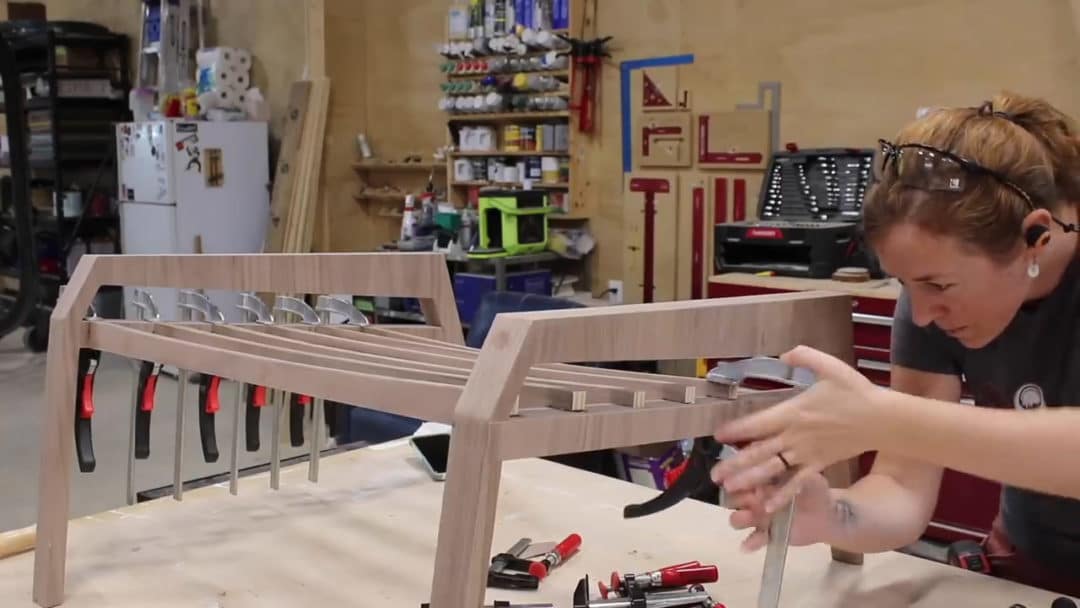

I used the clamps to seat the slats all the way, then a few bar clamps to seat the slats in the other direction as well.
And that’s the base done. Now lets make the back. I started off by making what will be the top and bottom rail of the back. These are identical with a few dados cut in to receive the vertical back slats later on so I once again used my cross cut sled to cut in these dados.

After I made all the dados, I ripped it down the center to divide it into the two rails needed. Doing it this way ensures they are in fact identical.
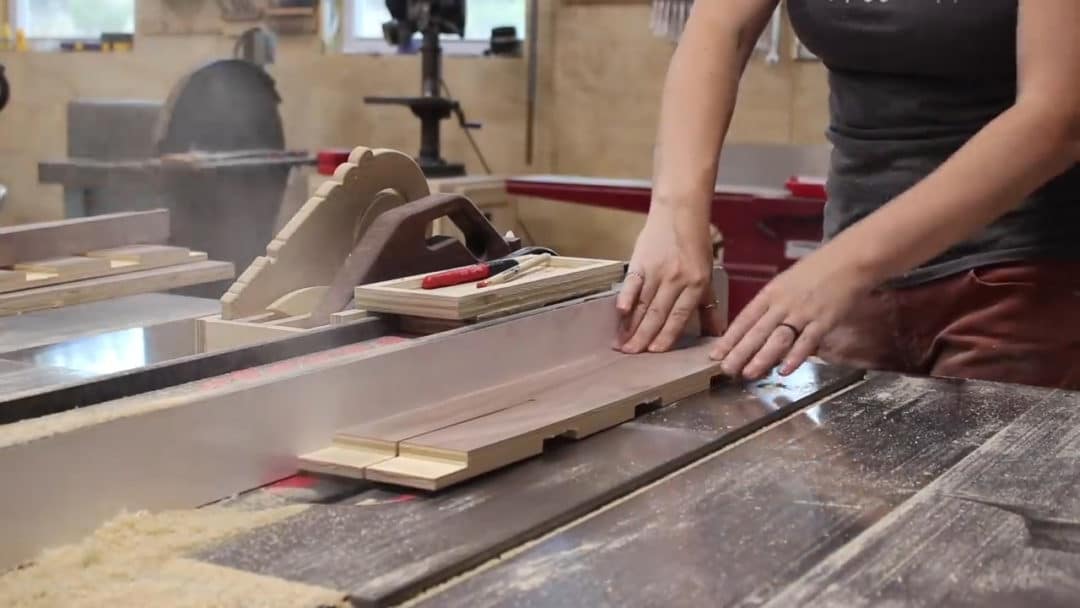
After cutting out the vertical slats using my template and a flush trim bit, I quickly edge banded the sides that would be exposed then joined them to the top and bottom rail. I switched over to using Titebond’s Thick and Quick for these easier glue ups because while it has the same holding strength as their other glue, it has an incredibly quick dry time and therefore reduced the amount of time I had to wait before moving on.

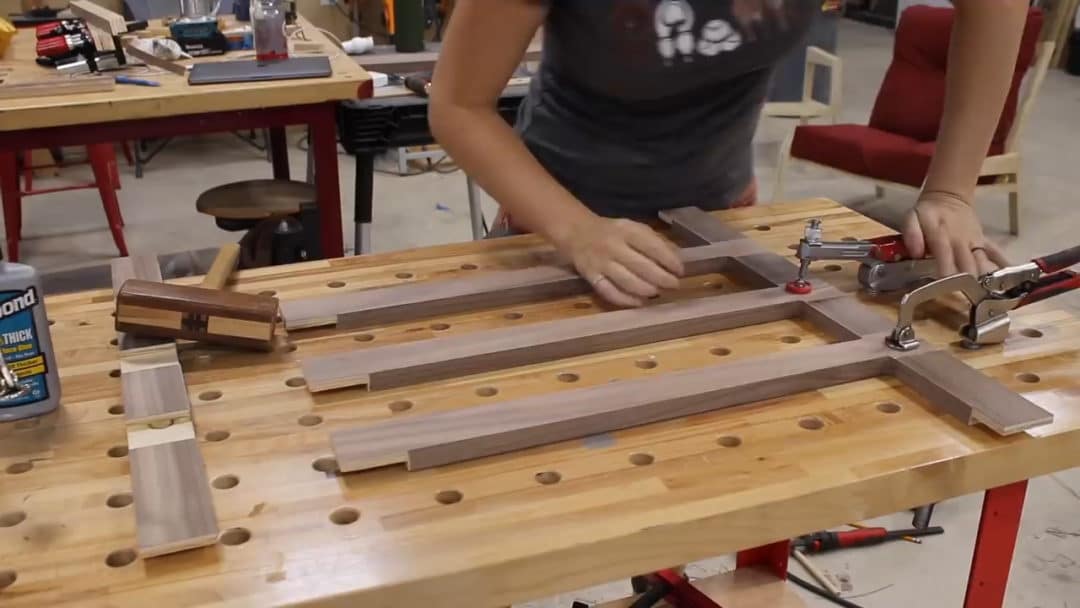
On the back, I waited until the vertical slats were attached to edge band both the top and bottom. Again, just so the joinery would be hidden and it would look seamless.
After I veneered the those edges I attached the last parts to make up the completed back. These end pieces are another part where I used my template to cut out. They are also another part that I thicken up by lamenting two parts together.

After edge banding the sides I applied some more Thick and Quick to the dado on the top and bottom rail then slid it into place and clamped it down to dry.

I let that set up, making sure to clean up the glue squeeze out before it dry completely, then moved on to attaching the completed back to the completed base. This is, not really a hard glue up but it does take some time so I switched back to using Titebond II since it has a longer open time than Thick and Quick, which gave me more time to move things around and get the back positioned perfectly before the glue started curing.
You can see I had clamps on the ready so that as soon as I got one side in it’s position I could quickly clamp onto it and move to the other side. I also am using a bevel gauge to make sure the angle of one side matches the other side.

After letting that dry in clamps over night I decided to reinforce the joint with a few screws and cover them up with walnut plugs. I first predrilled the four locations to pin the back to the base, then used a forstner bit to counterbore each one for roughly a 1/4” deep plug to be inserted in.

After driving in a screw to each hole I went to the drill press and used a plug cutter to make a few plugs. I cut these from solid walnut instead of the plywood so that I could leave some overhanging out of the hole to cut and sand flush.


I applied some Thick and Quick to each hole to attach the plugs, oh and I made sure to pay attention to grain orientation here so that the grain of the plugs ran with the arm/leg part and would blend better. After the glue was dry, I used a pull saw to cut them flush then some light sanding to finish them off.

Then since I was sanding, I went over the entire chair. Since this is plywood, I started off with 220 and made sure not to eat through the veneer but I did want to roam over all the surfaces to get them nice and smooth before finish.

Which was the next step. Ah, it’s always exciting to get to this point in the project. I’m personally going with a wipe on urethane finish and while you can use a foam or bristle brush, I typically just grab an old t-shirt and cut off a bit to use as my wipe on rag. I evenly coated all the surface then let it sit for a few hours before applying a second coat.
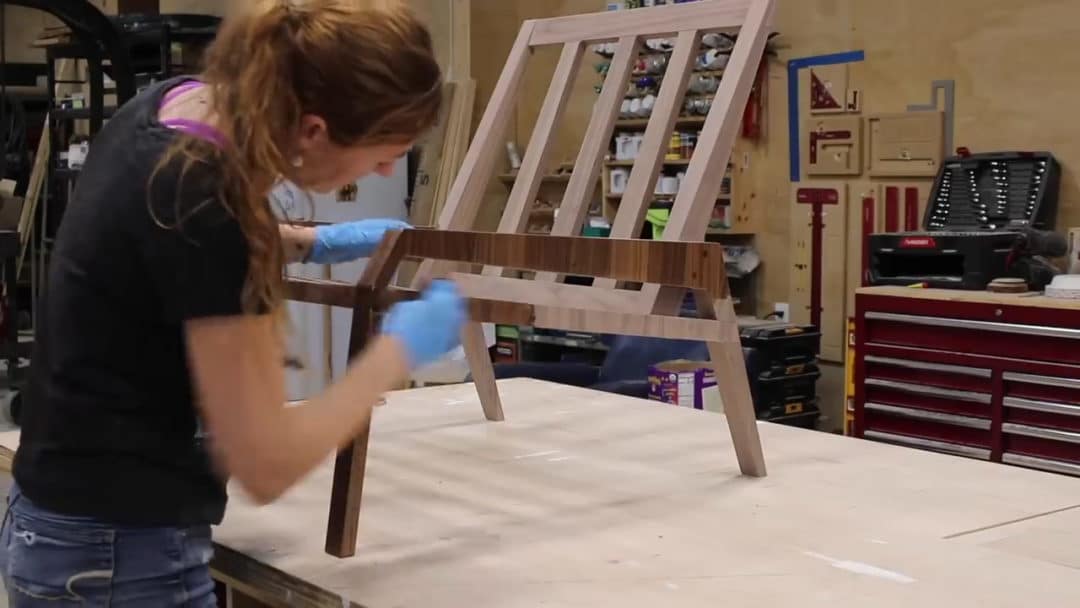
And that’s it. My goodness that was a pretty intimidating build. I’ve been putting off building a chair for a long time but I’m extremely pleased with how this chair came out looking and feeling.


Now I will have a dedicated place to not only sit and play but to also store all the stuff that goes with it.
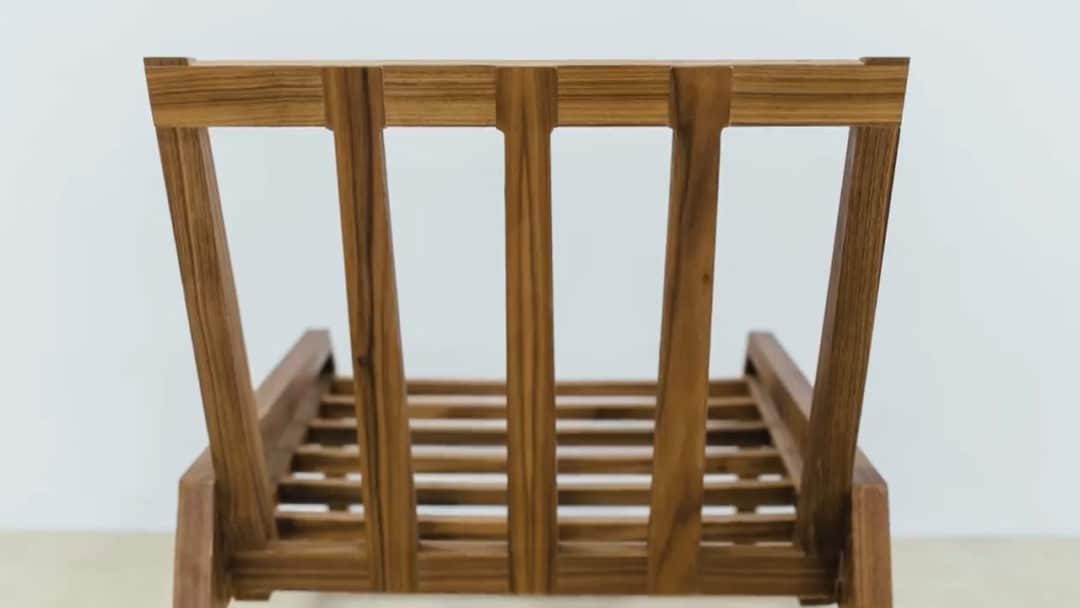


I hope that you enjoyed this project and I’ll see you on my next build!
If you haven’t already, don’t forget to sign up at the top of this page for my newsletter so you don’t miss new projects!
(Most of the links listed above are affiliate links. As an Amazon Associate I earn from qualifying purchases)
One Response
Great looking chair and awesome documentation on the build process. What did you do for cushions?
The links to the templates are not working yet.
Comments are closed.